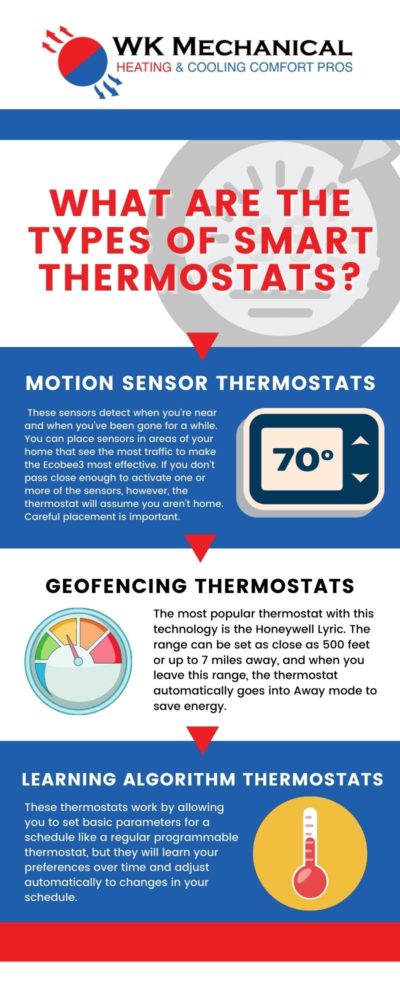Ready to take control of your heating and cooling system to minimize your utility costs? A smart thermostat can be a wise investment to save around $50 per year, according to Energy Star, or up to $100 or more depending on thermostat manufacturer’s claims.
Smart thermostats are an upgrade from programmable thermostats that can provide the same level of savings but that also require careful programming — something that many homeowners neglect. A 2015 study found that 40 percent of people who owned a programmable thermostat did not use its programming feature.
A smart thermostat fixes this oversight by making programming even easier, allowing you to change the temperature of your home from anywhere and “learning” your preferences to adjust your home’s settings automatically.
If you’re ready to upgrade to a smart thermostat, there are several types to choose from. Here’s how smart thermostats differ and what you should know to choose the right one.
Types of Smart Thermostats
There are three basic types of smart thermostats divided into categories based on the technology they use:
- Motion sensor thermostats
- Geofencing thermostats
- Learning algorithm thermostats
Algorithm-based smart thermostats are the most widely known and include the popular Nest Learning Thermostat and Honeywell Wi-Fi Smart Thermostat. These thermostats work by allowing you to set basic parameters for a schedule like a regular programmable thermostat, but they will learn your preferences over time and adjust automatically to changes in your schedule.
With the Auto-Away feature in the Nest thermostat, the thermostat will assume you are not home (even if it’s a time you should be home) when you don’t pass in front of 150-degree light and motion sensors for a long time. The thermostat will default to its more efficient Away mode. If the thermostat sees that you’re regularly away during the same time, it will adjust its schedule based on the new pattern.
Other smart thermostats use geofencing to know if you’re home or not. The most popular thermostat with this technology is the Honeywell Lyric. The range can be set as close as 500 feet or up to 7 miles away, and when you leave this range, the thermostat automatically goes into Away mode to save energy.
The downside of this technology? It doesn’t work very well if more than one person in the household uses the Lyric app with geofencing enabled. Working near your home can also trigger the Home mode as you travel.
Finally, the Ecobee3 uses remote proximity and motion sensors. These sensors detect when you’re near and when you’ve been gone for a while. You can place sensors in areas of your home that see the most traffic to make the Ecobee3 most effective. If you don’t pass close enough to activate one or more of the sensors, however, the thermostat will assume you aren’t home. Careful placement is important.
The right technology will likely come down to your preferences and lifestyle.
How Smart Thermostats Are Installed
Before choosing a smart thermostat, make sure you know how it’s installed to be sure it’s compatible with your heating and cooling system. Some smart thermostats require a C wire, so it’s important to know if your system has one.
The C wire, or common wire, provides continuous power to support features like an LED display. It’s necessary to install the Ecobee3, Ecobee3 Lite, and Honeywell Wi-Fi Smart Thermostat.
You can usually install a Nest Learning Thermostat or Honeywell Lyric with a four-wire system because the R-wire can be used as a workaround to supply the power the thermostat needs. With some systems, this can cause damage, however.
If you aren’t sure, it’s best to have a professional install your new smart thermostat.
Zone Control: Advanced Comfort Settings With Smart Thermostats
Do you want to be able to control different areas of your home separately? You may want to invest in a smart thermostat that supports multiple zones. Rather than controlling the temperature of your entire home, these thermostats can control the temperature of individual rooms to heat or to cool just rooms that are in use.
This type of smart thermostat uses remote sensors in each room in the zone. The Nest and Ecobee4 are the two most popular thermostats that support multiple zones. With the Nest, you need to purchase remote sensors separately at a fairly high cost. The Ecobee4 includes one remote sensor; additional two-packs cost less than one Nest remote sensor.
Are you interested in saving money on utilities and improving the comfort of your home with a smart thermostat? Contact our knowledgeable staff at WK Mechanical, Inc. in Middletown, NY, for help. We offer affordable thermostat installation compatible with your heating and cooling systems as well as indoor air quality services and heating and cooling installation, repair, and maintenance throughout the Hudson Valley.

